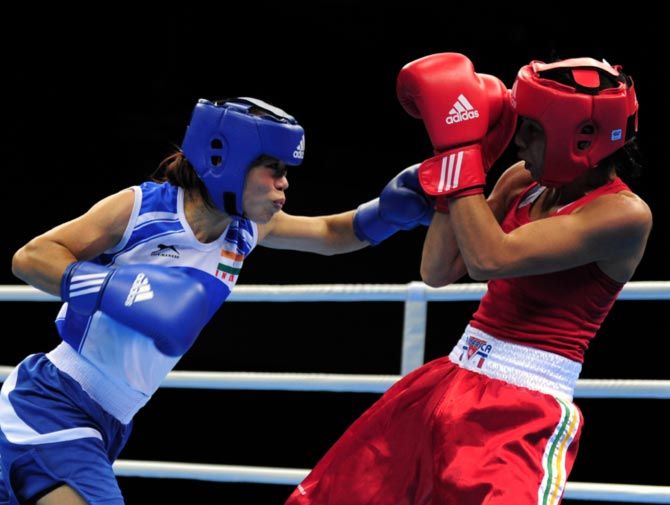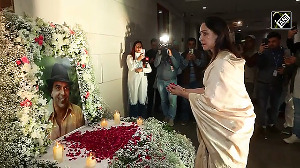Why did two Canadians make a documentary on women's boxing in India?
Harish Kotian/Rediff.com finds out.

It has been more than a decade since two young filmmakers from Canada started working on a documentary on Indian women's boxing. There were many obstacles along the way, but Ameesha Joshi and Anna Sarkissian never gave up hope on documenting a sport many in India did not know existed till M C Mary Kom's bronze medal win at the 2012 London Olympics.
Having funded the project from their own pockets, the duo set about recording everything possible related to Indian women's boxing and even visited the country a few times to cover boxing training camps and competitions since 2005.
Their hard work bore fruit when the documentary, With This Ring, was premiered at the Mumbai International Film Festival 2016 on Saturday, January 30.
In an e-mail interview with Harish Kotian/Rediff.com, Ameesha discusses what made her and Sarkissian devote much of the last 10 years on the film and how women's boxing scene in India has changed in recent years.
You worked for nearly ten years on this documentary on Indian women in boxing. What took you so long to complete it?
We never thought it would take this long and had every intention of completing all filming during our first production shoot to India in 2006.
Access to your characters is the key when you are a documentary filmmaker, and the boxers have very little free time. We came to India and lived alongside them at their hostels at the training camps. Their daily regimen is waking up at dawn, training, eating, sleeping, doing their laundry and repeating this cycle twice before the end of the day.
Sunday is their only day off in the week, so the demands of their schedules simply required us putting in the time to get what we needed. There was very little time for personal interviews and only a few weeks in the year are they at home visiting with their families.
Another major hurdle was the communication barrier. I grew up in Canada and can't speak Hindi; I can only understand a little. So communicating past a superficial level was challenging.
We had to find people who could help translate during interviews, and when we couldn't we conducted them anyways; we simply had no choice. This meant waiting until we got back to Canada to have the interviews translated until we could understand what they said.
For all these reasons it took time us to figure out who our main characters were going to be. It wasn't something we could rush; it was an organic process of observation that took some time.
This film was made on a small budget. After our shoot in 2006 it took a year-and-a-half of writing grant applications to the Canadian Art Councils to receive the funds in order to continue filming, which we did in 2008.
We managed to stretch these funds over four production shoots in India, two in China and one in Barbados. The documentary was pursued on the side since we both had school and/or full-time jobs. That said, if we had all the money and time in the world we would have finished the film in a short amount of time and missed out on all the events that occurred in our characters' lives over the six-year period.
Is the focus in With this Ring on how Indian women defied gender expectations and social barriers to triumph in what is considered the most difficult sport for women?
It is a portrait of three women's struggle to become championship boxers despite the many societal and familial pressures put on women their age.
It's also a look inside their personal worlds and life at the training camp, which is so unique and where the majority of their lives are spent.
When did this idea of making a documentary on Indian women's boxing begin?
The idea came to me back in 2005, when I went to see a World Press Photo Exhibit around the corner from where I lived in Montreal. There was a photo of a woman boxer practicing on the beaches of Madras, and I remember being struck by the fact that there were women boxers in India and knew right away what they must be up against to even pursue this sport.
I researched whatever I could find, and there was so little on the Internet at that time, but I did learn about Mary Kom, how little she had starting out in Manipur and that she was a two-time gold medal champion.
That same year I visited India to see family and decided to start my research at the same time. I discovered the boxing camps in India where they recruit and train the top boxers in the country year round.
These women were like no others I had met before on my sheltered family visits, and they made a strong impact on me.
Watching their skills during training just blew me away. And even their appearances. Some of them had short boy cuts and I remember one wearing a t-shirt that read 'Not all women are stupid some don't get married', and I just felt they were unique women with the strength of character to go against the grain and carve out their own path.
Another aspect that led me to want to make the film was the cinematic quality of their practice sessions.
It gave me chills the first time I saw 40, 50 girls shadow boxing and training in unison; the rhythm of the sounds and their movements were quite beautiful and photogenic.
So when it was announced in 2006 that the next World Championships were going to be in New Delhi, it was Anna who stated it was now or never.
So we borrowed equipment, did some fundraising and scraped up what we could to fly to India -- and it was so grateful since we captured them winning the World Championship team title and being crowned the No 1 team in the world.
How excited are you as the documentary gets ready to premiere in Mumbai?
There are no words to describe how excited we are to put this on a big screen after 10 years in the making. Our desire to share this with the world is long over due.
And the fact that we are premiering to Indian audiences is exactly what we wanted.
What made you so determined to study Indian women's boxing so closely?
It was more so the women behind the sport than the sport itself which captivated my interest. It was important to share the stories of these inspiring women who had accomplished so much against all odds and were falling so far under anyone's radar.
My instincts telling me to make this film were quite strong as weak. I never had any doubt in the idea along the way and always felt we were on to something special, and that kept me going through all the years.

Did anyone recognise MC Mary Kom back then in 2006?
In 2006, we hit the streets of Delhi asking people if they knew Mary Kom right after she won the (World Boxing Championships) gold... no, they hadn't heard of her.
It wasn't until 2012, right before the (London) Olympics, that we started finding people who knew Mary, but, even then, many often referred her to as that 'one lady boxer who's going to the Olympics.'
Having seen Indian women's boxing closely for the last 10 years, how much do you think has things changed since Mary's success at the London Olympics?
She also had a Bollywood movie, featuring Priyanka Chopra, based on her life and has a large fan following across the country...
Mary's Olympic win and her biopic starring Priyanka Chopra was the best thing to happen to women's boxing in India.
Popular media has incredible power to change people's mindset. I was happy to learn that there has since been a film on a woman wrestler and one on a woman boxer that's coming out right now in India.
Empowering stories of women pursuing these once male dominating sports, defying norms and gender stereotypes are commercially valued now, and that is a definite sign of change.
It's come a tremendous way since we began in 2006, but I feel it still has a long way to go.
We need to get to a place where it's not even an issue, where women, in any part of India, any socio-economic class, are supported to pursue any career or passion they desire.
What do you think of Mary Kom's achievements? She had to go through so much to get into boxing and then, even after having three sons, went on to win an Olympic medal.
We found Mary Kom incredible back in 2006. She literally started off with nothing and became the first woman in amateur boxing to win three World Championships medals. She only continued to astound us throughout the years.
When we returned to India in 2008, Mary had decided to come back to train a year after giving birth and returned to the boxing camp with her twin boys.
Witnessing her wake up at the crack of dawn after being kept up all night by her babies, and train intensely alongside the other boxers was definitely inspiring.
She's a force of nature with her skill, confidence and iron will; it's as if nothing can stop her. She has certainly earned her status as an icon.
That said, there are several women on the Indian team that are some of the best in the world and have been winning at an international level since 2006. It shouldn't have taken winning an Olympic medal for any of them to be receive proper recognition by the media.
Can you recollect the difficulties you faced while shooting the documentary in India?
Filming during the monsoon was tough for us, but we wouldn't dare complain when the boxers are enduring the same heat and training three times a day.
Their facilities and hostels at the time were not equipped with a/c, so there was no escaping the high temperatures. They were tough as nails and would adjust to whatever situation was thrown at them.
It's not easy being filmed, and the fact that the coaches and officials allowed us to live alongside them for so many months over the years. They were very understanding on their part.
We are grateful that the IABF (Indian Amateur Boxing Federation) officials, coaches and boxers were so cooperative.
You were supposed to release the documentary in 2012 or 2013 after the London Olympics. What caused the delay?
It took us over a year to find the right editor, but she was well worth the wait and the extra time it took to finish the film.
Jackie Dzuba has 20 years of experience editing for television and film, and her ability to carve out a narrative from such a vast amount of footage was impressive. We three all lived in different cities during the editing phase so the film was basically made over Skype.
Jackie would make a cut of the film, post it online, we would watch it, discuss over Skype and she would then integrate our notes and the cycle continued like this for over a year.
The process worked, but it was slow. It wasn't until the end that we decided it was necessary to fly out to where she lives in western Canada and work together for two weeks.
It was incredible for all of us to be in the same room and found we got more done in two weeks than we would have in months.











